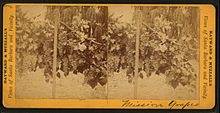- Mission (grape)
-
Mission grapes are a variety of Vitis vinifera introduced from Spain to the western coasts of North and South America in the 16th century by Catholic New World missionaries for use in making sacramental, table, and fortified wines.
Contents
History
The original European strain, until recently, had been lost, thus the grapes' being named "Mission grapes" since the Spanish missions are where they were generally grown. The grape was introduced to the Las Californias Province of New Spain, present day California, in the late 18th century by Franciscan missionaries. Until about 1850, Mission grapes, or Criolla, represented the entirety of viticulture in California wines. At the present time, however, Mission represents less than 1000 acres (4 km²) of total plantings in the entire state. Most of the state's remaining plantings are in the Gold Country, the Central Valley, and Southern California.[1]
Wines
Red and white wine, sweet and dry wine, brandy, and a fortified wine called Angelica were all produced from Mission grapes. Though Mission grape vines are heavy producers and can adapt to a variety of climates, table wine made from the fruit tends to be rather characterless, and thus its use in wine making has diminished in modern times. However as both contemporary accounts and those of the last two centuries attest, Angelica, the fortified wine made from the grape, is sometimes a wine of note and distinction. The Mission grape is related to the pink Criolla grape of Argentina and the red País grape of Chile.
European vines
In December 2006, Spanish scholars from the Centro Nacional de Biotecnología in Madrid, uncovered the name and origin of the mysterious Mission grape, as well as which were the earliest European vines grown in the Americas.[2] Their findings are due to appear in the journal of the American Society of Enology and Viticulture.[2] The scholars determined that the Mission grape's DNA matched a little-known Spanish variety called Listan Prieto.[2] Listan is another name for Palomino, a primary white grape used to make Sherry. Prieto means "dark or black".
Widely cultivated in 16th century Castile, Listan Prieto is now uncommon in Spain.[2] In Spain's Canary Islands, where it is known as Palomino Negro it is widely cultivated.[2] Scholars believe the grape's heyday ended in Spain when phylloxera destroyed much Spanish viticulture in the 19th century.[2]
See also
References
- ^ Jim LaMar (2002). "Mission". http://www.winepros.org/wine101/grape_profiles/mission.htm. Retrieved 2007-07-06.
- ^ a b c d e f Alley, Lynn (February 2007). "Researchers Uncover Identity of Historic California Grape: Spanish researchers solve mysteries surrounding the Mission variety and viticulture throughout the Americas". Wine Spectator Online. http://www.winespectator.com/Wine/Features/0,1197,3638,00.html. Retrieved 2007-03-30.
Categories:- California wine
- New Spain
- Pre-state history of California
- Red wine grape varieties
Wikimedia Foundation. 2010.

